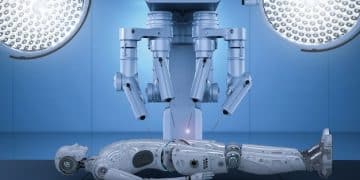The Future of AI-Powered Healthcare in the US: 5-Year Outlook

The future of AI-powered healthcare in the US over the next five years is poised for transformative advancements, driven by enhanced diagnostic accuracy, personalized treatment plans, and optimized operational efficiencies across the medical landscape.
The landscape of healthcare is on the precipice of a monumental shift, fundamentally reshaped by technological innovation. Specifically, The Future of AI-Powered Healthcare in the US: Predictions for the Next 5 Years presents a compelling narrative of change, promising to revolutionize everything from patient diagnostics to administrative functions. But what exactly can we expect from this intelligent integration, and how quickly will these advancements manifest in the complex American healthcare system?
The Foundational Pillars: AI in Diagnostics and Early Detection
The bedrock of effective healthcare lies in accurate and swift diagnostics. Over the next five years, artificial intelligence is projected to become an indispensable tool in this domain, significantly enhancing the precision and speed of identifying diseases. This integration moves beyond simply supporting human clinicians; it promises to augment their capabilities, revealing patterns and insights that might otherwise go unnoticed.
Imaging analysis, particularly in radiology and pathology, is an area ripe for AI-driven transformation. Algorithms can rapidly scan vast quantities of medical images—X-rays, MRIs, CT scans, and pathology slides—to detect subtle anomalies indicative of disease. This capability is not about replacing human experts but empowering them with an extra layer of scrutiny, reducing the potential for missed diagnoses and accelerating intervention. The consistency and tireless nature of AI analysis offer a significant advantage, especially in high-volume settings where human fatigue can be a factor.
Enhanced Imaging Analysis
Artificial intelligence excels at pattern recognition within complex datasets, making it ideal for medical imaging. This specialization allows AI systems to analyze scans with a level of detail and speed unmatched by human observation.
- Radiology Augmentation: AI assists radiologists in spotting minute lesions, early signs of cancer, or neurological disorders on complex scans, speeding up diagnosis and improving accuracy.
- Pathology Precision: Microscopic analysis of tissue samples benefits immensely from AI, which can identify cancerous cells or disease markers with greater consistency and less inter-observer variability.
- Predictive Analytics: Beyond detection, AI can predict disease progression or response to treatment based on image characteristics, offering a more proactive approach to patient care.
Genetic and Genomic Insights
The era of personalized medicine is here, and AI is its chief architect. By analyzing genetic and genomic data, AI can uncover individual predispositions to diseases and tailor preventative strategies or treatment plans. This predictive power allows for interventions long before symptoms manifest.
The ability to process and interpret massive genomic datasets provides unprecedented opportunities for understanding rare diseases and developing targeted therapies. This is particularly crucial in oncology, where genetic mutations dictate treatment efficacy. AI can sift through countless research papers and clinical trial results to cross-reference genetic markers with effective drug regimens, moving us closer to truly personalized medicine.
Personalized Treatment Plans and Drug Discovery Evolution
The “one-size-fits-all” approach to medicine is rapidly becoming a relic of the past, thanks to the advent of AI. Over the next five years, the US healthcare system will increasingly lean on artificial intelligence to craft highly personalized treatment regimens, moving beyond generalized protocols to strategies tailored to an individual’s unique biological makeup and medical history. This shift promises not only more effective therapies but also a reduction in adverse drug reactions and treatment failures.
AI models can synthesize vast amounts of patient data—including genetic profiles, lifestyle factors, electronic health records, and even real-time physiological monitoring—to predict how an individual might respond to various treatments. This level of granular insight allows clinicians to select the most appropriate drug, dosage, and therapy sequence, optimizing outcomes and minimizing trial-and-error. For instance, in cancer care, AI can suggest specific immunotherapies or chemotherapy regimens based on a tumor’s molecular signature, dramatically improving success rates.

The impact of AI extends profoundly into drug discovery and development, a notoriously lengthy and expensive process. Within the next half-decade, AI will significantly accelerate the identification of new drug candidates, predict their efficacy and toxicity, and streamline clinical trials. By analyzing molecular structures and biological pathways, AI can pinpoint promising compounds much faster than traditional laboratory methods.
Tailored Therapies Through Data Synthesis
AI’s capacity to integrate and analyze diverse data sources enables the creation of highly individualized treatment protocols. This multi-faceted approach considers all relevant patient information.
- Pharmacogenomics: AI interprets an individual’s genetic makeup to predict drug metabolism and response, ensuring the right medication at the right dose.
- Adaptive Treatment Pathways: For chronic conditions, AI continuously analyzes patient data from wearables and health records to adjust treatment plans dynamically, optimizing long-term health management.
- Rare Disease Solutions: By finding subtle commonalities across disparate patient cases, AI can help identify potential treatments for conditions that affect small populations, accelerating research progress.
Revolutionizing Drug Development
The journey from concept to market for a new drug is often a decade-long endeavor. AI is set to drastically cut this timeline by making every stage of the process more efficient and data-driven.
AI algorithms can sift through billions of chemical compounds to identify those with the highest potential therapeutic value, saving countless hours of physical laboratory work. Furthermore, AI can simulate how these compounds interact with biological systems, predicting potential side effects and optimizing dosages even before human trials begin. This predictive modeling reduces the number of failed candidates and focuses resources on the most promising avenues, leading to faster access to life-saving medications. The precision AI brings to drug discovery means more effective drugs reach patients quicker, with fewer costly setbacks.
Operational Efficiency and Administrative Automation
Beyond direct patient care, AI is set to fundamentally reshape the operational backbone of US healthcare over the next five years, driving unprecedented levels of efficiency and administrative automation. The healthcare system is notoriously complex and resource-intensive, burdened by vast amounts of paperwork, scheduling challenges, and billing intricacies. Artificial intelligence offers solutions to these perennial issues, freeing up human staff to focus on patient-centric tasks rather than clerical duties.
Imagine a hospital where patient scheduling is dynamically optimized, resource allocation for medical equipment and personnel is precisely calculated, and supply chains are managed with predictive analytics to prevent shortages. Such a future is not distant; AI algorithms are already proving their worth in these areas. By automating routine administrative tasks and optimizing logistical processes, AI not only cuts costs but also improves the overall flow and responsiveness of healthcare facilities. This operational streamlining translates into better patient experiences, reduced wait times, and more efficient use of valuable medical resources.
Streamlined Workflow and Resource Allocation
AI’s ability to process and predict patterns from operational data makes it an invaluable asset for improving the efficiency of healthcare facilities. This involves everything from managing staff to orchestrating patient flow.
- Optimized Scheduling: AI can intelligently schedule appointments, surgeries, and staff shifts to minimize wait times, reduce no-shows, and ensure optimal utilization of operating rooms and diagnostic equipment.
- Inventory Management: Predictive AI models analyze historical data and current demand to forecast equipment and medication needs, preventing stockouts and reducing waste in supply chains.
- Patient Flow Management: From admission to discharge, AI can track and optimize patient movement within a hospital, identifying bottlenecks and improving the overall patient journey.
Automated Administrative Tasks
The sheer volume of administrative work in healthcare consumes significant time and resources. AI offers powerful tools to automate these tasks, enhancing accuracy and allowing human staff to engage in more meaningful work.
Tasks such as insurance claim processing, medical coding, and electronic health record (EHR) data entry are prime candidates for AI automation. Natural Language Processing (NLP) capabilities enable AI to interpret and extract relevant information from unstructured clinical notes, automatically generate accurate billing codes, and flag potential errors before submission. This not only reduces the administrative burden on doctors and nurses but also significantly lowers operational costs and improves billing accuracy, leading to fewer denied claims and improved revenue cycles for healthcare providers.
Telehealth Expansion and Remote Monitoring Innovations
The past few years have accelerated the adoption of telehealth, and over the next five years, AI will propel this trend into an entirely new dimension within the US healthcare system. Artificial intelligence isn’t just facilitating virtual appointments; it’s transforming primary care, specialized consultations, and particularly, chronic disease management through advanced remote monitoring. This expansion promises to break down geographical barriers, improve access to care, and make healthcare more responsive and personal than ever before.
AI-powered telehealth platforms will evolve to offer more than just video calls. They will incorporate diagnostic capabilities, sophisticated chatbots for preliminary symptom assessment, and devices that measure vital signs remotely, all feeding into intelligent systems that can alert clinicians to potential concerns. This continuous, intelligent monitoring fosters a proactive healthcare model, where interventions can occur before conditions escalate, ultimately reducing hospitalizations and improving patient outcomes.
AI-Powered Virtual Consultations
Virtual care is poised to become more intelligent and comprehensive, with AI providing essential support to both patients and practitioners. This evolution goes beyond mere connectivity, embedding intelligence directly into the consultation process.
- Symptom Checkers: Advanced AI chatbots will offer highly accurate preliminary diagnoses and triage advice, guiding patients to the appropriate level of care and reducing unnecessary clinic visits.
- Diagnostic Support: During virtual consultations, AI can analyze patient-reported symptoms, medical history, and even facial expressions or vocal patterns to assist clinicians in diagnosis.
- Personalized Follow-ups: AI customizes post-consultation instructions and reminders, ensuring patients adhere to treatment plans and manage their health effectively.
Revolutionizing Remote Patient Monitoring (RPM)
The ability to continuously monitor patient health parameters from a distance is a game-changer, especially for managing chronic conditions or post-operative recovery. AI elevates RPM from simple data collection to intelligent analysis and intervention.
Wearable sensors and home medical devices, imbued with AI, will continuously collect a wealth of physiological data—heart rate, blood pressure, glucose levels, oxygen saturation, and activity patterns. AI systems will then analyze this data in real-time, identifying subtle deviations that could signify a worsening condition. Instead of just passive data logging, AI will provide actionable insights, triggering alerts to caregivers and clinicians when intervention is required, often preventing emergencies. This proactive approach significantly enhances patient safety and comfort, allowing many to manage their health more effectively from home.
Ethical Frameworks, Data Security, and Regulatory Landscape
As AI penetrates deeper into the fabric of US healthcare, the next five years will be critical in establishing robust ethical frameworks, ensuring unassailable data security, and navigating an evolving regulatory landscape. The transformative power of AI comes with significant responsibilities, and addressing these concerns transparently and proactively is paramount to fostering public trust and ensuring equitable implementation. Without these safeguards, the immense potential of AI in healthcare risks being undermined by legitimate public apprehension and systemic vulnerabilities.
The ethical implications of AI in healthcare are multifaceted, touching upon issues of bias, accountability, and the autonomy of both patients and clinicians. Algorithms are only as impartial as the data they are trained on; therefore, ensuring diverse and representative datasets is crucial to prevent biased diagnostic or treatment recommendations. Similarly, questions of who is accountable when an AI system makes an error—the developer, the clinician, or the institution—must be clearly defined to instill confidence in these tools.

Data security, already a major concern in healthcare, becomes even more critical with the proliferation of AI. The vast amounts of sensitive patient data required to train and operate advanced AI systems present an attractive target for cyber threats. Robust encryption, stringent access controls, and continuous monitoring will be essential to protect patient privacy and prevent data breaches. The regulatory environment, often slow to adapt to rapid technological advancements, must evolve quickly to encompass AI. This includes developing clear guidelines for AI development, deployment, and oversight, ensuring that these powerful tools are used responsibly and for the greater good.
Addressing Bias and Ensuring Fairness
The ethical deployment of AI mandates a rigorous focus on preventing and mitigating algorithmic bias, which can lead to disparities in care.
- Representative Datasets: Prioritizing the use of diverse and inclusive patient data for AI training to ensure models perform accurately across all demographics.
- Audit Trails and Transparency: Developing “explainable AI” systems that can articulate their reasoning, allowing clinicians to understand and trust AI recommendations.
- Human Oversight: Ensuring that human clinicians retain ultimate decision-making authority, with AI serving as an assistive tool rather than an autonomous decision-maker.
Fortifying Data Security and Privacy
Protecting sensitive patient information is non-negotiable. As AI systems process more data, the need for advanced security measures intensifies.
Implementing state-of-the-art encryption, multi-factor authentication, and blockchain technologies can create a virtually impenetrable shield around patient data. Regular security audits and compliance with evolving regulations like HIPAA in the US will be essential. Furthermore, educating healthcare professionals and patients about data risks and best practices for digital health will build a collective defense against cyber threats, cementing trust in AI-powered healthcare solutions.
The Human Element: Physician Adaptation and Patient Acceptance
As AI increasingly integrates into US healthcare over the next five years, the narrative won’t solely be about technological advancement but equally about the profound adaptation of the human element: how physicians embrace these new tools and how patients accept this evolving model of care. The success of AI-powered healthcare hinges not just on its technical prowess but on its seamless integration with human expertise and its ability to build patient confidence. This involves a significant cultural shift, demanding education, training, and thoughtful communication to bridge the gap between traditional practices and AI-driven innovations.
For physicians, AI represents a shift from being the sole interpreter of data to a collaborator with intelligent systems. This necessitates new skills, including understanding AI outputs, integrating AI-driven insights into clinical reasoning, and communicating these insights effectively to patients. Medical education and continuous professional development will need to evolve rapidly to equip current and future clinicians with the competencies required to leverage AI effectively. The goal is to augment, not diminish, the physician’s role, allowing them to focus on the nuanced aspects of patient care that require empathy, judgment, and complex interpersonal skills.
Patient acceptance is equally crucial. While the promise of more accurate diagnoses and personalized treatments is compelling, patients may harbor concerns about data privacy, algorithmic errors, or the perceived dehumanization of care. Transparency from healthcare providers about how AI is used, clear explanations of AI’s benefits and limitations, and assurances about data security will be vital in building trust. Engaging patients in the process, perhaps through educational campaigns or user-friendly interfaces that demystify AI, will be key to fostering widespread adoption and ensuring that AI-powered healthcare truly serves its ultimate beneficiary: the patient.
Physician Training and Collaborative Care Models
The successful integration of AI requires a proactive approach to physician education, preparing them for a future where technology is a core partner in patient care.
- Curriculum Modernization: Medical schools and residency programs will incorporate AI literacy, data interpretation, and human-AI collaboration as standard components of training.
- Continuous Professional Development: Existing clinicians will require ongoing training programs to stay abreast of AI advancements and learn how to effectively use AI tools in their daily practice.
- Augmented Intelligence: Emphasizing that AI acts as an assistant, enhancing diagnostic capabilities and decision-making, rather than replacing the critical thinking and experience of the human doctor.
Fostering Patient Trust and Engagement
The ultimate success of AI in healthcare depends on patients’ willingness to embrace these new technologies. This requires careful consideration of their concerns and proactive communication.
Healthcare providers must clearly articulate the benefits of AI, such as increased accuracy and personalized treatment, while addressing common fears around privacy and algorithmic bias. User-friendly interfaces for AI-powered remote monitoring and telehealth tools can empower patients, making them active participants in their own healthcare journey. Open dialogues and ethical guidelines that prioritize patient well-being and data security will solidify trust, ensuring that individuals feel secure and valued within an AI-enhanced healthcare system.
Investment Trends and Public-Private Partnerships
The next five years will witness a significant acceleration in investment and the proliferation of public-private partnerships, driving the rapid advancement and deployment of AI in US healthcare. This surge is fueled by the undeniable potential of AI to improve health outcomes, reduce costs, and enhance accessibility—factors that attract both venture capital and governmental backing. The sheer scale and complexity of integrating AI across the diverse American healthcare landscape necessitate collaborative efforts, pooling resources, expertise, and regulatory foresight from various sectors.
Venture capital firms, pharmaceutical giants, tech innovators, and even traditional healthcare systems are pouring billions into AI research and development. This investment isn’t just targeting groundbreaking algorithms; it’s also funding the infrastructure required to scale these technologies, from secure cloud computing platforms to specialized data centers. The focus is on solutions that demonstrate clear ROI, whether through improved diagnostic accuracy, more efficient drug discovery, or optimized operational workflows. This financial impetus is a crucial propellant for AI’s rapid evolution and adoption.
Public-private partnerships will play an equally vital role, especially in addressing broader public health challenges and ensuring equitable access to AI technologies. Governments, academic institutions, and private companies are increasingly collaborating on initiatives to standardize data, develop ethical guidelines, and fund research into AI applications for underserved populations. These collaborations can accelerate regulatory approvals, facilitate widespread implementation, and ensure that the benefits of AI are accessible beyond just the most well-resourced institutions. The synergy between private sector innovation and public sector oversight will be key to unlocking the full potential of AI-powered healthcare for all Americans.
Strategic Investments in AI Healthcare Startups
The startup ecosystem is a hotbed of innovation, with specialized AI companies developing solutions for niche and broad healthcare challenges alike.
Strategic investments often target startups focusing on areas like precision medicine, AI-driven diagnostics, automated administrative tools, and telehealth platforms, recognizing their potential to disrupt and modernize healthcare. These investments provide the capital necessary for research, development, and scaling, bringing innovative AI solutions from concept to widespread clinical use. The competitive landscape among these startups fosters rapid innovation, pushing the boundaries of what AI can achieve in healthcare.
Collaborative Approaches to Data Standardization and Policy
The fragmented nature of healthcare data poses a significant challenge to AI integration. Partnerships are essential to overcome this hurdle and shape a conducive regulatory environment.
Public and private entities are collaborating to develop common data standards and interoperability protocols, allowing AI systems to seamlessly access and analyze information across different healthcare providers. This data harmonization is crucial for training robust AI models. Furthermore, these partnerships are instrumental in shaping policy and regulation, ensuring that AI development is guided by ethical considerations, patient safety, and equitable access, while still fostering innovation.
| Key Area | 5-Year Prediction |
|---|---|
| 📊 Diagnostics & Early Detection | Significant enhancement in precision and speed of disease identification via AI-powered imaging and genomic analysis. |
| 💊 Personalized Treatment | Highly tailored treatment plans based on individual patient data, accelerating drug discovery and therapy optimization. |
| ⚙️ Operational Efficiency | Automation of administrative tasks, optimized scheduling, and predictive resource allocation for streamlined healthcare operations. |
| telehealth & Monitoring | Advanced virtual consultations and intelligent remote patient monitoring for proactive, accessible care. |
Frequently Asked Questions About AI in US Healthcare
Over the next five years, AI will significantly enhance diagnostic accuracy by rapidly analyzing vast quantities of medical images (X-rays, MRIs) and complex genomic data, identifying subtle patterns often missed by the human eye. This will lead to earlier detection of diseases like cancer and neurological disorders, allowing for more timely and effective interventions across the US healthcare system.
No, AI is not expected to replace doctors; instead, it will augment their capabilities. In the next five years, AI tools will act as powerful assistants, handling data analysis, automating routine tasks, and providing diagnostic support. This will free up physicians to focus on complex decision-making, patient interaction, and empathetic care, enhancing the overall quality of healthcare delivery.
AI will revolutionize personalized medicine by analyzing individual patient data, including genetics, medical history, and lifestyle, to create highly tailored treatment plans. This means prescribing the most effective drugs and dosages, predicting responses to therapies, and minimizing adverse reactions, moving away from generalized approaches toward individualized care within the next five years.
Key ethical concerns include algorithmic bias, ensuring data privacy and security, and defining accountability for AI-driven errors. The next five years will focus on developing robust ethical frameworks, using diverse datasets to prevent bias, implementing stringent data protection, and establishing clear regulatory guidelines to ensure responsible and equitable AI deployment.
AI is predicted to positively impact healthcare costs by improving operational efficiencies, automating administrative tasks, and reducing diagnostic errors. It will enhance accessibility through expanded telehealth services and remote monitoring, particularly for underserved populations. While initial investments are high, the long-term outlook suggests more cost-effective and accessible care over the next five years.
Conclusion
The journey toward an AI-powered healthcare system in the US over the next five years is not merely an incremental upgrade but a profound transformation. From the precision of early detection and the personalization of treatment to streamlined operations and expanded telehealth, artificial intelligence is poised to redefine what is possible in medical care. While challenges around ethical considerations, data security, and human adaptation remain, proactive investments and collaborative efforts are paving the way for a future where healthcare is more accurate, efficient, accessible, and ultimately, more human-centric. The predictions indicate a period of rapid evolution, promising a healthier and more intelligently managed future for all Americans.





